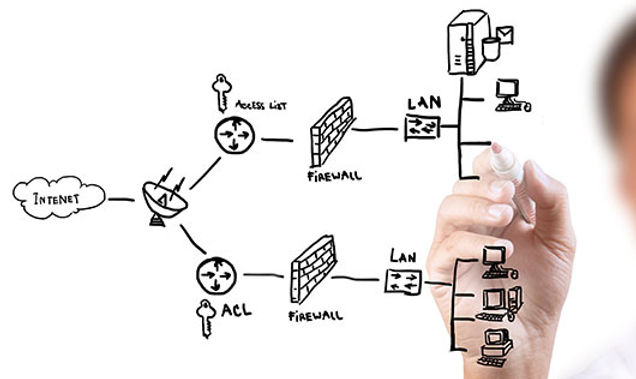
With the rise of cloud computing, remote work, and mobile devices, traditional network security models have become no longer as effective as they used to be.
Secure Access Service Edge (SASE), is a transformative approach that converges networking and security into a unified, cloud-native solution. SASE is not just a buzzword—it’s the future of network security, designed to meet the demands of modern enterprises.
The Core Components of SASE
SASE integrates multiple security and networking functions into a single framework. The primary components include:
- SD-WAN (Software-Defined Wide Area Networking)
- Security Services
- Cloud-Based Architecture
SD-WAN
SD-WAN optimizes the performance of wide area networks by intelligently routing traffic across multiple connections, ensuring that users experience fast and reliable access to applications, whether they are hosted on-premises or in the cloud.
Security Services
SASE incorporates essential security functions such as firewall-as-a-service (FWaaS), secure web gateways (SWG), cloud access security brokers (CASB), and zero trust network access (ZTNA). These services work together to provide comprehensive protection against threats, no matter where users and applications are located.
Cloud-Native Architecture
Unlike traditional security models that rely on data centers, SASE is built for the cloud. This architecture ensures that security policies are enforced consistently, regardless of where the user is located or which application they are accessing.
Why SASE is Essential for Hybrid Work Environments
Hybrid work has become the new norm, and as more employees access corporate resources from various locations, the need for secure, seamless connectivity has never been greater.
Traditional VPNs (Virtual Private Network), while useful for providing remote access, have significant limitations. They offer unrestricted access to the business network, which can introduce security risks if not effectively managed. Additionally, routing all application traffic through a central data center is no longer practical in an era where most applications live in the cloud.
SASE addresses these challenges by providing granular control over network access and ensuring that users can securely connect to applications no matter where they are. This is particularly crucial for hybrid work environments, where employees need the flexibility to work from anywhere without compromising security.
How SASE Enhances Security and Network Performance
One key benefit of SASE is its ability to enhance security and network performance. Traditional network security models often struggle with the sheer volume of traffic generated by modern applications, leading to bottlenecks and inefficiencies. SASE overcomes these challenges by:
Optimizing Traffic Flow
SASE uses SD-WAN to intelligently route traffic based on the most efficient path, reducing latency, and improving the user experience.
Implementing Zero Trust
SASE incorporates zero trust principles, which means that no user or device is trusted by default. Every access request is authenticated, authorized, and encrypted, ensuring that only legitimate users can access sensitive resources.
Protecting Against Emerging Threats
With its cloud-native architecture, SASE is continuously updated to defend against the latest threats, providing enterprises with real-time protection.
The Benefits of SASE for Modern Enterprises
Modern enterprises stand to gain numerous benefits from implementing SASE, including:
Scalability
As a cloud-based solution, SASE can easily scale with the needs of the business, whether that means supporting more users, more locations, or more applications.
Cost Efficiency
By consolidating networking and security functions into a single platform, SASE reduces the need for multiple point solutions, lowering overall costs.
Simplified Management
SASE offers centralized management through a single interface, making it easier for IT teams to monitor and enforce security policies across the entire organization.
Improved User Experience
With optimized traffic routing and reduced latency, users enjoy faster and more reliable access to applications, which can lead to increased productivity.
Implementing SASE: Key Considerations
While SASE offers numerous advantages, there are important considerations for businesses looking to implement this framework:
Vendor Selection
Choosing the right SASE provider is critical. Looking for a vendor with a strong record of accomplishment in both networking and security, as well as the ability to deliver a fully integrated solution that meets your specific needs and compliance requirements.
Migration Strategy
Transitioning to SASE requires careful planning. Businesses should start by assessing their current infrastructure and identifying which components can be replaced or integrated with SASE.
User Training
To maximize the benefits of SASE, training your employees on how to securely access resources and use new security tools provided by the SASE framework is essential.
Compliance
Ensure that the SASE solution complies with industry regulations and standards, particularly if your business handles sensitive data.
The Future of SASE, Conclusion, and Next Steps
As businesses adopt cloud technologies and remote work, SASE is poised to play an increasingly significant role in network security. The future of SASE will see further integration with artificial intelligence and machine learning, enabling even more sophisticated threat detection and response capabilities.
Additionally, as the SASE framework matures, we can expect to see greater adoption across industries, making it a standard for secure access for cloud-based environments.
In a world where hybrid work and cloud computing are the norm, SASE provides a robust, scalable solution for securing access to critical business resources. By converging networking and security into a single cloud-native framework, SASE ensures that enterprises can meet the demands of hybrid and remote work.
Ready to transform your network security with SASE? Explore BTI’s industry-leading SASE solutions and discover how we can help your business achieve secure, seamless access to applications from anywhere. Contact us today to schedule a consultation and take the first step towards a more secure, agile IT network infrastructure. Need additional IT services? We can help!



